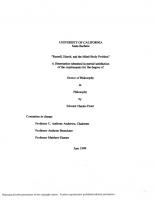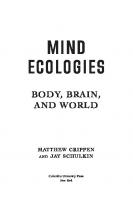Body and Mind: Second Edition [2 ed.] 0268006725, 9780268006723
Widely used in philosophy courses, this succinct study explores the problem of determining the relation between the body
128 106 9MB
English Pages 178 Year 1984
Cover
BODY AND MIND
Title
Copyright
Contents
PREFACE TO THE SECOND EDITION
1. THE MIND-BODY PROBLEM AND ITS PLACE IN PHILOSOPHY
(i) What the Problem Is
(ii) Assumptions Involved in the Mind-Body Problem
(iii) The Importance of the Mind-Body Problem
2. HOW THE MIND-BODY PROBLEM ARISES
(i) Four Incompatible Propositions
(ii) The Initial Plausibility of All Four Propositions
3. DUALISMS
(i) Philosophical Objections to Spirit
(ii) Scientific Objections to Spirit
(iii) lnteractionist Dualism
(iv) Parallelism
4. THE BEHAVIORIST SOLUTION
(i) The Behaviorist Doctrine of Mental States
(ii) The Mind-Body Problem and the Problem of Other Minds
(iii) Behaviorism and Mental Causes
(iv) Mental Episodes
(v) The Strength of Behaviorism
5. CENTRAL-STATE MATERIALISM
(i) The Causal Theory of the Mind
(ii) The Significance of Mental Terms
(iii) Central-State Materialism
(iv) The Causal Theory of Mind Examined
(v) The Causal Theory of Mind Amended
6. FUNCTIONALISM
(i) Artificial Intelligence
(ii) Materialism and Chauvinism
(iii) Embodiment and Supervenience
(iv) Strength and Problems of Functionalism
7. A NEW EPIPHENOMENALISM
(i) The Old and New Epiphenomenalisms
(ii) Double Aspect
(iii) The New Epiphenomenalism and the Mind-Body Problem
(iv) The Problems of Other Minds
(v) The Problems of Evolution and Embryonic Development
(vi) The Current State of the Mind-Body Problem
BIBLIOGRAPHY
INDEX
Recommend Papers
![Body and Mind: Second Edition [2 ed.]
0268006725, 9780268006723](https://ebin.pub/img/200x200/body-and-mind-second-edition-2nbsped-0268006725-9780268006723.jpg)
- Author / Uploaded
- Keith Campbell
File loading please wait...
Citation preview
BODY AND MIND
Keith Campbell was born into an academic family in Wellington, New Zealand, in 1938. He studied at the Victoria University of Wellington and at Oxford in the early 1960s and became a lecturer and then senior lecturer in the University of Melbourne ( 1963-65). Since 1966 he has worked in the University of Sydney. He was elected to the Australian Academy of the Humanities in 1977 and has been a visiting fellow in the Australian National University and at universities in New Zealand. He is the author of Metaphysics, An Introduction (Dickenson, 1976) and of more than thirty contributions to various philosophy journals.
BODY AND MIND by KEITH CAMPBELL Second Edition
UNIVERSITY OF NOTRE DAME PRESS
Notre Dame, Indiana 46556
Second Edition 1984 University of Notre Dame Press edition 1980 First published by Anchor Books, 1970 Reprinted by arrangement with Doub1eday and Company Copyright© 1970, 1984 by Keith Campbell
Library of Congress Cata1oging in Publication Data Campbell, Keith, 1938Body and mind. Bibliography: p. Includes index. I. Mind and body. I. Title. BD450.C244 1984 128'.2 ISBN 0-268-00672-5 ISBN 0-268-00673-3 (pbk.)
84-13082
Manufactured in the United States of America ISBN 9780268161026 This e-Book was converted from the original source file by a third-party vendor. Readers who notice any formatting, textual, or readability issues are encouraged to contact the publisher at [email protected].
Contents
PREFACE TO THE SECOND EDITION
vii
1. THE MIND-BODY PROBLEM AND ITS PLACE IN PHILOSOPHY
30
(i) What the Problem Is
(ii) Assumptions Involved in the Mind-Body
Probkm
(iii) The Importance of the Mind-Body Problem
30 4 9
2. HOW THE MIND-BODY PROBLEM ARISES
14
(i) Four Incompatible Propositions
14
(ii) The Initial Plausibility of All Four
Propositions
3. DUALISMS (i) Philosophical Objections to Spirit
(ii) Scientific Objections to Spirit
25 41 41
(iii) lnteractionist Dualism
48 50
(iv) Parallelism
55
4. THE BEHA VIORIST SOLUTION (i) The Behaviorist Doctrine of Mental
States
(ii) The Mind-Body Problem and the
Problem of Other Minds
59 59 63
(iii) Behaviorism and Mental Causes
65
(iv) Mental Episodes
71
(v) The Strength of Behaviorism
74
vi
Body and Mind
5. CENTRAL-STATE MATERIALISM (i) The Causal Theory of the Mind
(ii) The Significance of Mental Terms
77 77 82
(iii) Central-State Materialism
86
(iv) The Causal Theory of Mind Examined
97
(v) The Causal Theory of Mind Amended
104
6. FUNCTIONALISM (i) Artificial Intelligence
(ii) Materialism and Chauvinism (iii) Embodiment and Supervenience
(iv) Strength and Problems of Functionalism 7. A NEW EPIPHENOMENALISM (i) The Old and New Epiphenomenalisms
(ii) Double Aspect (iii) The New Epiphenomenalism and the
110 114 115 119 122 124 126 127
Mind-Body Problem
130
(iv) The Problems of Other Minds (v) The Problems of Evolution and Embryonic Development
132
(vi) The Current State of the Mind-Body
Problem
135 138
BIBLIOGRAPHY
140
INDEX
165
PREFACE TO THE SECOND EDITION
This edition differs from the original in including an additional chapter, Chapter 6, Functionalism, which sets forth the most important development in the philosophy of mind since this book first appeared in 1970. The bibliography has been expanded and brought upto-date with a guide to the literature of Functionalism and with selected additions to the entries concerning other aspects of the Mind-Body problem.
Chapter 1
THE MIND-BODY PROBLEM AND ITS PLACE IN PHILOSOPHY (i) What the Problem Is
The problem with which this book deals, the MindBody problem, can be posed most briefly in a single question: What is the relation, in a man, between his mind and his body? The problem is really more general, of course, for if animals other than men, or bodily creatures on other planets, have minds too, then there will be a problem about the relation of their minds to their bodies. I dare say we can generalize whatever conclusion we reach about ourselves to cover animals rather like us, and with luck it might even extend to extraterrestrial beings. In any event men, being concerned most with themselves, have concentrated chiefly on their own case; we will follow this tradition and postpone the wider problem. So the Mind-Body problem will be for us the problem of determining in what relation a human mind stands to a human body. It is clear that to get a firm grasp of even the problem, let alone its solution, we must also settle two further questions: What is a human body? What is a human mind? The three questions are thoroughly intermingled-a situation quite common in philosophy. Views of what
2
Body and Mind
body and mind are help determine answers to the MindBody problem, and the troubles involved in some answers to the Mind-Body problem can in turn discredit some opinions about body and mind. Because the questions are so interconnected, when we tackle the Mind-Body problem we must at the same time also work toward answering the questions about mind and body. The Mind-Body problem is three problems rolled into one. As a first step, we must get clear what we are thinking about in using the terms "body" and "mind".
''Body'': Provided you know who you are, it is easy to say what your body is: it is what the undertakers bury when they bury you. It is your head, trunk, and limbs. It is the collection of cells consisting of your skin and all the cells inside it. It is the assemblage of flesh, bones, and organs which the anatomist anatomizes. It is the mass of matter whose weight is your weight. "Mind": What are we talking about when we talk about a man's mind? In philosophy, we need to use words in ways which beg the fewest questions, so a suitably non-committal explanation of the meaning of "mind" begins: The mind is what differentiates a man from other less interesting objects in the world-plants, rocks, and masses of gas, for example. These other things have no mind. Men are different; "mind" names the difference. But we must be more specific than that. For many features distinguish a man from a rock, a tree, a wax dummy, or a corpse. And most of these differences con-
The Mind-Body Problem
3
cern bones, blood, digestion, temperature, skin constitution, and so on, which have nothing in particular to do with the mind. To single out the distinguishing marks of men which are of the "mental" kind, we must confine our attention to differences of activity, not anatomy, between men and mindless beings. Men do all manner of things: jump, laugh, fall, digest, think, build, collide. Of the activities on this short list, a rock can only fall and collide. Trees and corpses are similarly restricted in their range of activity. It is because men do many things that rocks, trees, and corpses do not, that we say they have minds. So more explicitly: To speak of the mind is to speak of the activities which distinguish a man from a rock, tree, dummy, or corpse. Indeed, so essential is activity to our idea of mind that we sometimes say only beings with minds can do anything at all. Things just happen to rocks and maybe even trees. On this way of talking, things without minds do not act at all, and have no activities. But whether or not we choose to count colliding, growing, or dying as activities, it is by the range of their activities that beings with minds are distinguished from those without one. Without begging questions, we can go a bit further and begin an inventory of the mind, a systematic description of the various mental elements. An inventory of the mental features of a normal adult includes sensation, perception, thinking, memory, and belief; intention, decision, purpose, action, and want; pain and pleasure, emotion, and mood; and qualities of temperament or personality, such as generosity, courage, or ambition.
4
Body and Mind
We can summarize the inventory by saying that there belong to the mind four overlapping families of items, the families of thinking, acting, feeling, and character. And we can use this summary to state the Mind-Body problem a little more fully. The Mind-Body problem is the problem of what relations hold between the brain and the bag of bones which is your body on the one hand and whatever is involved in the, activities of thinking, acting, feeling, and character which distinguish you as a being with a mind on the other. As already noticed, to solve this problem we must at the same time advance fuller accounts of the mind and the body. So far, they have only been pointed out as topics for further investigation.
(ii) Assumptions Involved in the Mind-Body Problem
The Assumption that the Mind Is a Thing Up to this point we have expressed the Mind-Body problem as a problem concerning the relationship between two things. This is a natural and ordinary way of talking; many expressions in English treat the word "mind" as a noun which, just like "body", denotes a thing. For example: "His mind is clear" ("His body is thin"), "Thoughts raced through his mind" ("Bullets rushed through his body"), "He improved his mind by study," "In senility his mind decayed," and a thousand more. But it is important to be wary of this assumption, for perhaps the mind is not a thing at all. The incontestable fact that a normal adult has a mind (and only
The Mind-Body Problem
5
one) no more proves that there is such a thing as the mind which he has, than the fact that you have diabetes proves that there are such objects as diabetes, some of which you possess, or the fact that someone gives you the creeps shows that there are creeps, some of which be bands over. We must be wary of the assumption because it is exactly what some accounts of the mind-notably, Bebavioristic accounts-deny. Bebaviorists proceed to a treatment of the Mind-Body problem on the basis that the mind is not a thing. For them, the Mind-Bocy problem is not a question of the relation of two separate things. It is a question, rather, of bow a man's bodily and mental characteristics are related. The Mind-Body problem is, in such cases, perhaps better named the Mental-Physical problem. Our original way of putting the Mind-Body problem suggests that the mind is a thing. This suggestion is open to challenge, but the challenge affects only the way the Mind-Body problem is posed, and not that problem itself. For we will still want to know in what the mental characteristics of a man consist, and what relation they bear to his physical characteristics. Our problem remains, but it appears in a new light and invites a different solution. The Assumptions of Homogeneity
Again, the way the Mind-Body problem has been posed so far involves assuming that all of what belongs to the body is of one sort, and all that belongs to the mind is equally of one sort, though perhaps different from the body. We shall later find reason to doubt these
6
Body and Mind
assumptions. But they are the correct
![Body and Mind: Second Edition [2 ed.]
0268006725, 9780268006723](https://ebin.pub/img/200x200/body-and-mind-second-edition-2nbsped-0268006725-9780268006723-a-6539026.jpg)





![Body never forget: the psychological trauma healing in the brain. mind and body(Chinese Edition) [Standard ed.]
9787111532637, 7111532635](https://ebin.pub/img/200x200/body-never-forget-the-psychological-trauma-healing-in-the-brain-mind-and-bodychinese-edition-standardnbsped-9787111532637-7111532635.jpg)
![Medieval Animals On The Move: Between Body And Mind [1st Edition]
3030638871, 9783030638870, 9783030638887](https://ebin.pub/img/200x200/medieval-animals-on-the-move-between-body-and-mind-1st-edition-3030638871-9783030638870-9783030638887.jpg)
![The Orangeman, Second Edition: The Life and Times of Ogle Gowan, Second Edition [Second edition]
9780228013686](https://ebin.pub/img/200x200/the-orangeman-second-edition-the-life-and-times-of-ogle-gowan-second-edition-second-edition-9780228013686.jpg)
